We didn't start out intending to feed ourselves in such a big way. Actually it started out because, frankly, I just loves me some homegrown tomatoes.
Now, seven years later, we've advanced to the point where we eat no less than two meals a week YEAR ROUND that are predominantly from our own homegrown food. In the late summer, early fall it's more like four or five meals a week.
Wholesome, organically-grown produce with a path from plant to plate that's all of about 50 yards.
Now that's what I call eating locally!

Our gardening starts in late January/early February when we start planting the seeds we ordered right after New Year's Eve. The tomato seeds are saved from the previous year and we are now on our seventh generation for our Speckled Roman tomatoes. We plant a garden that's about 1200 total square feet and our emphasis is on tomatoes and peppers. We plant about 55-60 tomato plants in the garden, around 90 chili peppers (seven varieties, over half of which are jalapenos) and 30 sweet peppers.

The peppers and tomatoes go under lights on timers in a warmed corner of our basement along with herbs (two kinds of parsley, basil, and Thai basil), Ping Tung eggplants, and Listada de Gandia (striped purple) eggplants.
In mid-march, we start planting in our cloches or cold frames. Into these go cold-tolerant plants like Swiss Chard, several types of lettuce, mizuna, pak choy, radishes and carrots.
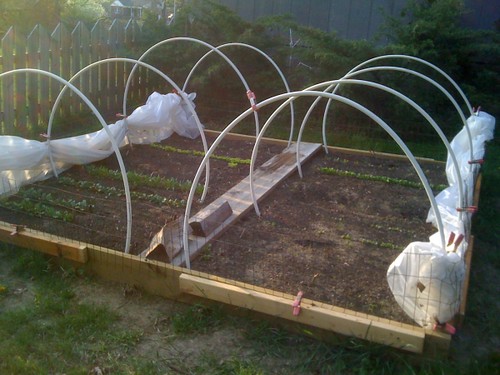
Opened during the day to allow the spring sun to warm the soil, we cover them with the plastic at night to keep them from getting too cold. On a 50°F day, temperatures inside the cloches can exceed 80°F so opening them during the day is essential. During this time we also plant peas which actually prefer the cool weather.
As the basement seedlings get big enough, we begin the hardening process, moving them out to a hardening box I made from some scrap wood and old windows we got that the local ReStore, Habitat for Humanities outlet for used supplies. Bit by bit they are exposed to the sunshine to avoid sunburning them (we nearly lost all our tomatoes in the early days because of this) until they are hardy enough for planting.
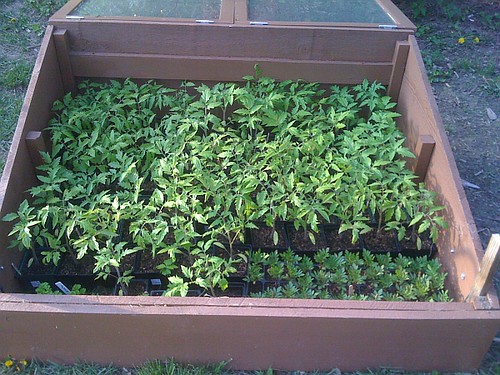
The main garden is prepared by tilling in organic compost made by us or, in busy years, purchased from the Ann Arbor Compost Center. This year we actually spread 8 cubic yards on the gardens to really improve the soil and, wow! what a difference it made.
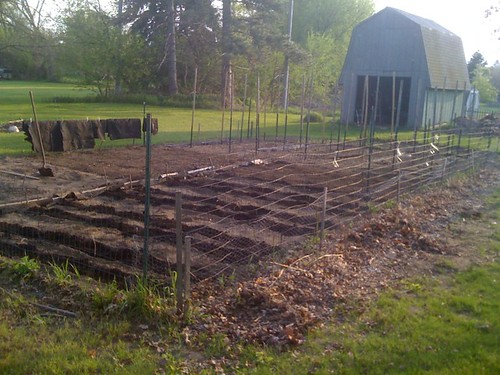
In this photo you can see where I have placed the rich, dark compost into the rows where the peppers will go and can see the stakes in the back where we'll plant tomatoes. As the tomatoes get big, we'll use a weaving technique between the posts to keep them growing upright. This is a much more effective technique than tomato cages or tying them to individual posts.
In addition to our seedlings, we plant a wide variety of seeds directly into the garden: cilantro, Swiss Chard, kale, Brussels Sprouts, zucchini, cucumbers, onions, and kohlrabi.
By July, the garden looks like this:

By late August, we're in full preservation mode. We can upwards of 55 quarts of tomatoes, mostly our favorites: Speckled Romans.

We also bread eggplant disks, par-bake them and freeze them for eggplant parmesan throughout the year.
From this:

to this:
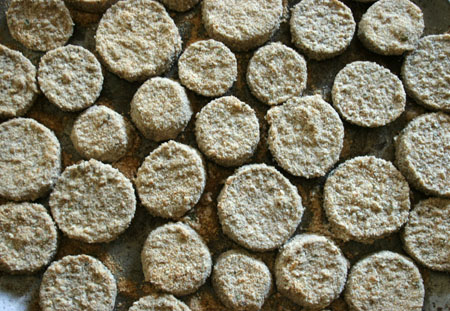
Eggplants are also grilled and frozen for the Indian dish, Baingan Bartha. Chili peppers are stuffed and grilled and frozen with our very own special filling. Paprika and jalapeno peppers are smoked and dried to make smoked paprika and chipotle peppers.

Jalapeno peppers are stuffed, breaded and par-baked for freezing. We do about 600-800 of these and you can get a free recipe along with instructions HERE.
From this:

to this:
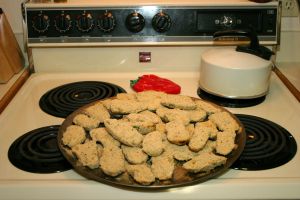
Bell peppers are diced and frozen as well as stuffed and frozen. Jalapeno and serrano chilies are diced and frozen. Some chilies are dried for making crushed chili pepper flakes. Swiss Chard is wrapped around mozzarella cheese, basil, and onion and then grilled and frozen. It's a busy time for us right now but it's a labor of love.
In October we'll plant garlic that we harvest in early July and asparagus that was planted last year will start bearing fruit for us next year.
We have an acre but you can do so much on so much less. In the process you'll lower your carbon footprint dramatically and fill your life and belly with nutritious homegrown food. It's amazing how much of a dent it makes in our grocery bill all year round. And it reconnects you to the earth in a way I never anticipated.
It's good for your soul.
I'm just sayin'...
=-=-=-=-=-=-=-=-=-=
The GOOD photos are by Anne Savage and you can see more of her terrific food photography at her Edibles Flickr page.
UPDATE: If you are interested in pest control methods we use for our organic garden, check out my diary on this topic HERE.


